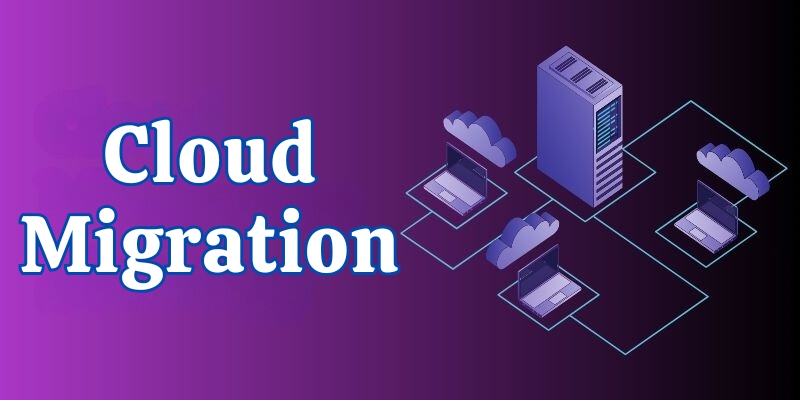Successful Cloud Migration Strategy: Ultimate Guide
In today's fast-paced digital landscape, businesses of all sizes increasingly turn to cloud-based solutions to streamline their operations and achieve improved scalability, flexibility, and cost savings.

One such solution is Amazon Web Services (AWS), a leading provider of cloud-based services. AWS cloud migration can be a game-changer for your organization, but only if executed correctly. But in this guide we will cover all about "Cloud Migration" with great detail.
So, guys, without wasting any time, let us dig in.
What is Cloud Migration?
Cloud migration means moving your data, apps, and tools from your computer systems to the cloud.
The cloud is like a big online storage space where you can keep everything safe and access it from anywhere. Instead of using physical servers, companies use cloud services to store and manage their work.
Importance of Cloud Migration in Modern Businesses
Cloud migration helps businesses stay updated and work faster. It allows companies to save money, improve performance, and grow without worrying about storage or space.
For example, if a business needs more resources, the cloud makes it easy to add them quickly. It also helps teams work together even if they are in different places.
Why is Cloud Migration Strategy Important?
A cloud migration strategy is like a step-by-step plan that helps you move to the cloud smoothly. A good plan helps you:
- Save time by knowing what to do first.
- Avoid losing important data.
- Make sure everything works correctly after the move.
- Stay within your budget without spending extra money.
Key Considerations Before Migrating
So, guys, if you are ready to start your cloud migration journey, wait a moment!

Before jumping into it, here are some key things you must think about to make sure everything goes smoothly.
1. Assessing Business Needs
Take a close look at what your business needs. Ask yourself:
- Why do you want to move to the cloud?
- What are the most important apps or tools you use every day?
This step helps you understand what to prioritize during migration.
2. Choosing the Right Cloud Model
There are three main types of cloud models:
- Public Cloud: You share space with other users. It is budget-friendly.
- Private Cloud: Only your business uses it. It is more secure.
- Hybrid Cloud: A mix of both public and private. It gives you more flexibility.
Pick the one that fits your business goals and security needs.
3. Budget Planning
Plan your costs wisely! Make sure you know:
- How much you will spend on moving to the cloud.
- The ongoing costs for using cloud services.
This step helps you avoid spending more money than you expected.
4. Regulatory Compliance
Check if your business needs to follow any rules or laws. For example, some industries, like healthcare or finance, must keep data private and secure. Make sure your cloud provider meets these requirements.
5. Team Readiness
Ask yourself: Is your team ready for the cloud? They might need training to understand how to use cloud tools. Preparing your team will make the transition much easier and faster.
Types of Cloud Migration Strategies
After understanding the key considerations, it’s better to know the types of cloud migration strategies and why they matter. Each one has its own purpose. Here’s a simple breakdown:
1. Rehosting (Lift-and-Shift)
- Move applications and data to the cloud without any changes.
- Quick and easy for businesses needing a fast migration.
2. Replatforming (Lift-and-Optimize)
- Make small changes to improve performance during migration.
- Useful for better results without a complete redesign.
3. Refactoring (Re-architecting)
- Redesign applications to take full advantage of cloud features.
- Best for creating modern, cloud-native tools.
4. Repurchasing
- Replace old software with new cloud-based solutions.
- Ideal for businesses upgrading outdated systems.
5. Retiring
- Remove old or unnecessary applications.
- Saves resources by not moving outdated tools.
6. Retaining
- Keep some apps or data on-premise instead of moving them.
- Good for sensitive data or tools that perform better locally.
Step-by-Step Guide to Successful Cloud Migration
Here is a simple step-by-step guide to help you move to the cloud successfully.

Follow these steps carefully for a smooth migration:
1. Define Clear Objectives
- Set clear goals for why you are migrating to the cloud.
- Examples: Reduce costs, make systems scalable, or improve performance.
2. Assess Your Current Environment
- Check your current applications, servers, and tools.
- Identify dependencies and any areas that might need adjustments.
3. Develop a Migration Plan
- Create a roadmap for what to migrate and in what order.
- Start with less critical applications before moving important ones.
4. Choose a Cloud Provider
- Compare providers like AWS, Microsoft Azure, or Google Cloud.
- Look at their pricing, features, and reliability to pick the best one.
5. Prepare Your Infrastructure
- Make sure your systems meet cloud compatibility, security, and compliance needs.
- Address any gaps or risks before starting the migration.
6. Migrate Applications and Data
- Move your applications and data to the cloud step by step.
- Test everything during the process to ensure smooth functionality.
7. Monitor and Optimize
- Keep an eye on performance after migration.
- Optimize resources to reduce costs and improve efficiency.
Common Challenges in Cloud Migration
Understanding data migration challenges can help you anticipate and mitigate potential pitfalls during this critical stage.
Here are the most common issues and how to solve them:
1. Downtime During Migration
- Challenge: Systems may become unavailable during migration.
- Solution: Use phased migration and schedule the move during low-traffic times to minimize downtime.
2. Data Loss or Corruption
- Challenge: Important data might get lost or corrupted during the process.
- Solution: Back up all data before migration and test the process in a secure environment.
3. Cost Overruns
- Challenge: Unexpected expenses can make migration costlier than planned.
- Solution: Monitor cloud usage closely and set budgets to avoid unnecessary spending.
4. Compliance Issues
- Challenge: Not meeting legal or security requirements can lead to penalties.
- Solution: Work with a cloud provider that meets all regulatory standards for your industry.
5. Lack of Expertise
- Challenge: Teams may not have enough knowledge about cloud migration.
- Solution: Train your team or hire external consultants to guide the process.
Tools and Services for Cloud Migration
Here are some helpful tools and services to make your cloud migration smoother and more efficient:
1. Migration Assessment Tools
- Tools that help you assess your current environment and plan the migration.
- Examples: AWS Migration Hub, Azure Migrate
2. Data Migration Tools
- Tools for moving your data safely to the cloud without losing anything.
- Examples: CloudEndure, Carbonite
3. Application Migration Services
- Services that help you move your applications to the cloud.
- Examples: Google Cloud Anthos, VMware Cloud
4. Monitoring and Optimization Tools
- Tools that help you track performance and manage cloud costs after migration.
- Examples: CloudWatch (AWS), Dynatrace
Conclusion
So, guys, it’s time to wrap up. In this article, we’ve covered the cloud migration guide in detail. We explored different strategies, tools, and challenges to help you succeed.
I recommend focusing on clear goals and preparing your infrastructure before starting the migration process. Cloud migration can be a game-changer for your business, so don’t hesitate—take action now and start planning your migration to the cloud!



Please Write Your Comments